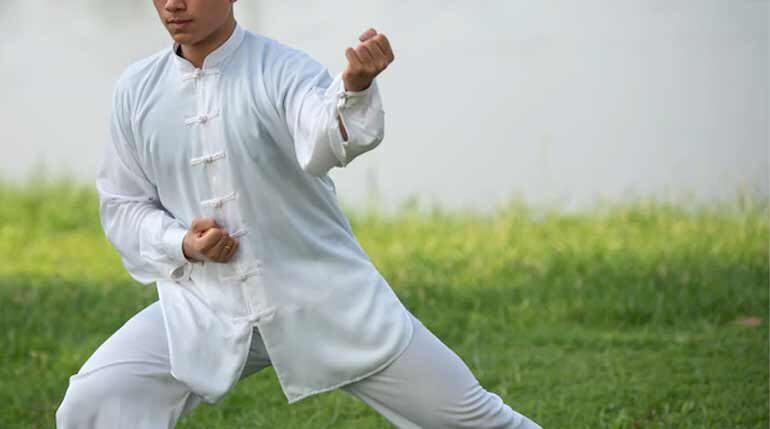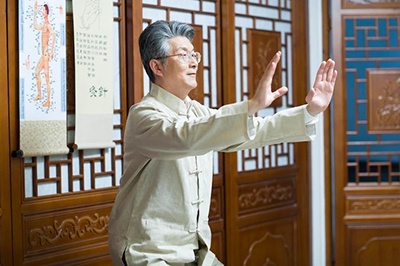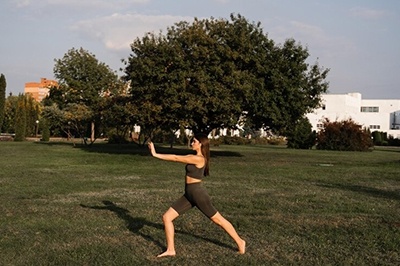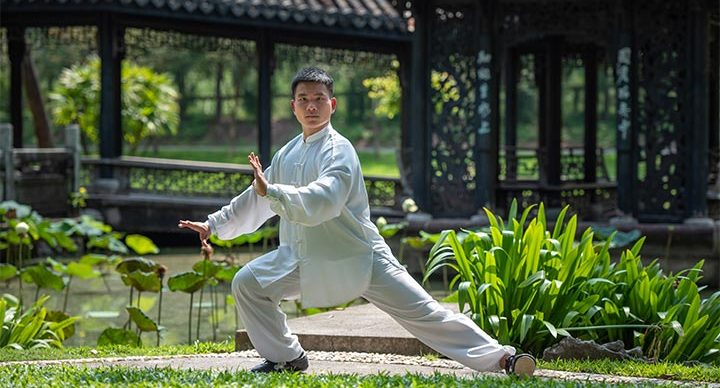
If you are interested in learning Tai Chi you should know that there are various components of Tai Chi, which I will elaborate upon in this article. They are The Eight Active ingredients of Tai chi, all intertwined with each other. To start with let us take the simple example of a tablet used in medicine, which is used, say to lower blood pressure and cholesterol. There are various elements and constituents in such a drug that work in tandem with each other to have the desired impact on the physiology of the body. In exactly the same way, Tai Chi has many more ingredients, which are therapeutic in nature and synergize with each other, to create a holistic and multi-component exercise that affects us at all levels. Here I refer to physical, mental, social and even psychological levels! Its multifaceted consequences are especially useful, when it comes to dealing with deep-seated diseases that affect the many systems throughout our body.
Let us break it down:
The Eight Active Ingredients of Tai Chi are as follows

- Awareness (including alertness and focused consciousness)
- Intention (including belief and expectation)
- Structural Integration (including active form and function)
- Active Relaxation (meditation in motion, flowing to deeper levels of relaxation)
- Strengthening and Flexibility (unified movements, leading to less strain and better equilibrium)
- Natural, Freer Breathing (methodical breathing that helps to regulate the nervous system)
- Social Support (including interconnection and community)
- Embodied Spirituality (including ideology and customs)
1.Awareness
It is commonly advocated to start all Tai Chi lessons with awareness. The idea is to be focused on your consciousness to what the body is experiencing. You have to be mindful of your breathing and allow yourself to be fully involved in the present moment. Can you understand the ease with which you are breathing? Can you enjoy the warmth of your breath spreading through your nostrils? Can you follow it as it enters your body? Do not make too many shifts in how you are breathing or standing. Just take it all in. Allow yourself to feel freely. While you are standing become conscious of yourself. Are you putting more weight on one foot than another? Where are you feeling the pressure on your feet? The inner edges or the outer edges? We thus move forward slowly and mindfully, alerting ourselves to the different parts of the body, not making any conscious changes but just being aware. This is the beauty of Tai chi, allowing the senses to flow freely.
Heightened body and self- awareness, and a sustained ability for focal attention without the disadvantages of over thinking or judging, are the profound components of Tai Chi. Research has shown that there are benefits to the mind, and body from these alone. Heightened body awareness might also play a role in improving muscular conditions such as back pain, by helping to determine the poses and stretching which would be safe therapy as well as strengthen the limbs in the long term. This is called a kinaesthetic sense. Developing this sensitivity is a key component to the martial arts application of Tai Chi. Tai Chi awareness also places emphasis on mental focus. The idea is to learn from experience, and not repeat the mistakes of the past. This way we will be better planned for the future. We have to keep excessive distraction at bay.
Tai Chi is an active focused meditation. Take an example, of a paper towel that absorbs and holds water in its pores, in the same way let your mind be open and cradled by the fabric of the body. Finally, this ingredient is also crucial, in allowing you to derive the advantages of the other ingredients such as the correct postures and breathing stances.
2. Intention
Here we shift into a new realm of adding intent to awareness. Now we add imagery, like imagine you are in a roomful of nourishing salts. Slowly imagine them wafting through the room, seeping into your skin nurturing you with their goodness. Continue to feel them permeating through your body, dissolving unwanted toxins and leaving you refreshed and reinvigorated. This ingredient helps us to perceive, build images and accept bodily changes. Imagery can significantly influence our brain, and thus affect our physiological functions. Tai chi takes advantage of this. It brings to life the phrase ‘imagination becomes reality’. Thus, one can visualise and envisage a better condition for oneself.
Also included in this ingredient is a simple exercise called washing yourself with QI (qigong exercise). Here simply ask the students to visualize themselves standing on a hilltop or a beach, feeling the fresh air, allowing the energy to permeate them and revitalizing themselves. It is like a wash with healing energy that rejuvenates your entire being.

3. Structural Integration
One of the crucial essentials of Tai Chi, which is also reflected in the symbols of yin-yang is dynamic integration. The integration of the supporting components results in a more harmonious whole. The important part of this ingredient is enhancing integration. Our entire body is connected through conjoining tissues. It is a living matrix that connects every cell of your being. Can you feel the inner ocean connect to your feet, ankles, and knees? Can you feel the flow of ‘juices’ caressing and nurturing the connective tissues in your body? The concept of integration is related to the evolutionary biological principle of form and function, that is, where shapes and patterns of movements show results across many body systems. Form and function even extend to emotion. If you improve your structural organization, you not only breathe efficiently but you also improve your emotional and mental stability.
4. Active Relaxation
In this ingredient lies the intrinsic wisdom to find balance. It is a popular notion to push oneself, or to give it a 110 %. However, this aggression may not work at times and you are actually causing harm to your body. Here comes the importance of striking a balance and putting in moderation in effort and active relaxation. Nearly everyone be it young or old, has had an experience of pushing themselves, resulting in them injuring themselves. It could be straining a back muscle, turning too fast, tearing a knee ligament or hurting an elbow. Tai Chi definitely develops strength and an increased range of motion but it does so slowly, helping to reduce and minimize injury. Relaxation is a very important ingredient and an active concept in Tai Chi.
When your body relaxes, it releases tensions and feels lighter. Your relaxed Tai Chi body helps you to become physically stronger and emotionally free. Being relaxed in Tai Chi, does not mean a complete loose body structure. It means to maintain a relaxed, snug like upright body structure that is exquisitely aware of your tensions, strains and internal dynamics. Tai Chi helps in the coordination of our body dynamics and assists in making you relax in the flow.

5. Strengthening and Flexibility
One of the primary reasons that Tai Chi is considered as healing is because it serves as an effective form of physical exercise. Intertwined with meditation and integrative ingredients is a physical workout that includes aerobic and flexibility training. An exceptional point to be noted is that Tai Chi is considered highly safe and an adaptable form of exercise for most people. It is not restricted to the younger breed only, but also helps to improve the quality of life for middle aged and older people. Tai Chi works as an aerobic exercise, though the intensity is moderate and not as fast paced as other aerobic exercises. It is a safe and effective form of physical exercise. Tai Chi also promotes strength training. Tai Chi won’t help you to get a muscular physique to compete, but it can provide relevant strength for both the lower and upper body. It helps to maintain strong bones, increases lower muscle extremity strength, and lowers rates of bone loss. Lastly, Tai Chi is also used as flexibility training due to the repetition of movements in a slow and relaxed fashion. Tai Chi enhances overall flexibility. The warm up exercises that are associated with it help to loosen up the muscles and keep our joints and tendons lubricated.
6. Natural, Freer Breathing
One of the fundamental elements of Tai Chi is efficient, mindful breathing. Tai Chi employs slow regular breathing, accompanied by good posture and having a flexible structure. How does this help us? In times of emotional stress our body mechanisms, such as our heart beat become fast paced and irregular. This causes rapid and shallow breathing. Here, Tai Chi helps us to focus on our breathing allowing it to flow freely through our body, resulting in relaxation and reversal of such chronic changes. The deep breathing positively affects the nervous system.
There are various breathing techniques in Tai Chi, but the universally recognized one is natural breathing. Tai Chi works on the principle that breathing creates an internal massage. The breathing is directed to the various parts of the body, concentrating on a particular part, helping to positively increase blood flow within the organ, creating an internal massage.

7. Social Support
As mentioned earlier, Tai Chi is a holistic form of exercise. It looks at all the aspects of your well-being, not just physical. To this end, being a part of a social group has innumerable benefits. The feeling of belonging, of have social support and connections has huge and positive impacts on your health. This sense of belonging actually leads you to have a longer life span. So how does Tai Chi figure in this?
Tai Chi instructors play innumerable roles. They motivate you, coach you and even offer therapy as and when needed. They form inter-personal relationships especially with long term students, and this results in a strong social support. Social interactions can deeply impact your health. Research has proved that social activities such as attending events together, preparing meals and participating in fitness activities together has been associated with longer survival.
8.Embodied Spirituality
Tai Chi principles are like a beacon of shining light, that guide you throughout life. There is an amalgamation of body, mind and spirit. The approach of Tai Chi is not just to benefit your physical well-being, but to unify the aspects of your psychological and social well-being as well. An important aspect of Tai Chi is spirituality.
Throughout history, medicine has been deeply embedded in spirituality. Even today most people do believe in God or a universal power. In dire times of need they turn to prayer. When people face illnesses, many turn to spiritual beliefs for comfort and solace. Tai Chi helps to make the connection between spirituality and the universe.
Consecutively attending Tai Chi classes becomes like a ritual and becomes therapeutic. Regular practice regimens keep you actively involved with like-minded people. Inclusively, these icons and rituals create culturally meaningful and healing experiences through Tai Chi.
Thus, The Eight Active Ingredients of Tai Chi, have a beneficial impact that encompasses your mind, body and soul. Call us to hire an offline or online Tai Chi Trainer for yourself and see the benefits of Tai Chi for yourself!
Do not miss a single article!
Submit your email id to get new articles directly into your email inbox!
- How We Conduct Online Zumba Sessions for Employees - December 30, 2022
- Prenatal Yoga During First Trimester - December 14, 2022
- Healthy Eating and Nutrition at the Workplace - October 13, 2022

Add Review